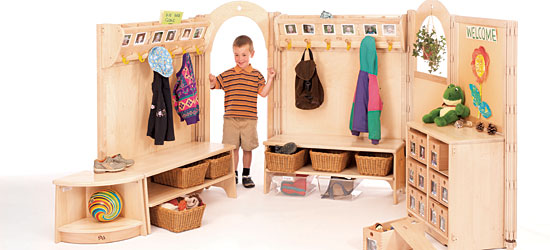Transform your children’s coat hooks
| June 2012A warm welcome matters
Does the entry to your centre proclaim to parents and visitors, “Here is a place for children?” Or does the inevitable jumble of damp jackets and general clutter in cramped quarters convey indifference?
“Adults admire their environment; they can remember it and think about it – but a child absorbs it. The things he sees are not just remembered; they form part of his soul. He incarnates in himself everything in the world about him that his eyes see and his ears hear.”
Why is the meeting place of parents, carers and children so often overlooked? It seems to be thought of last (or not at all) when people are designing a new centre, whereas it should be the first thought! Consider the meaning of the welcome area – building a bridge between the two worlds in which our children grow up. Parents need to feel confident that their children will be looked after in a happy, loving atmosphere, so the place in which children are turned over must help inspire that confidence.
Children and parents form an impression of your centre’s ethos from the moment they enter. How can you convey a home-like, welcoming feel? To begin with, there must be enough space so that parents do not feel they must quickly leave to make room for the next arrivals. You want to draw parents in, to stay and interact. Bear in mind that curves are more inviting than hard corners. Children (and parents) may feel intimidated if confronted by a large reception desk, so consider having the desk to one side and providing child-size furniture where possible. A peaceful feeling can be strengthened with natural lighting, wood surfaces, wicker baskets and living plants, and a homely touch can be added with drapes and curtains. Your choice of fabrics and artwork can articulate your appreciation for children’s diverse backgrounds.
A well-designed welcome area can create:
- Initial welcoming impact, inviting to all, with clear and informative directions
- Space for staff members, parents and children to interact informally at the beginning and end of each day
- Secure and inviting areas where parents leave and collect their children
- Comfortable seating for parents and children
- A place for each child to call his own, to store his outdoor clothes and personal belongings
- A system for communications with parents
- Informative areas for displays and notice boards
- Storage for push chairs and car seats
The area where jackets should be hung is debatable. Some practitioners like it by the door to the outside play area. Some prefer it at the front entry. Many are forced by various constraints to use part of the playroom itself. Hence the need for a flexible system. The features of any good system for clothes and belongings are:
Why children's coat hooks should be high quality
Poorly designed coat hooks result in coats spending the majority of their time on the floor. Pegs should have a large rounded end to make them safer for eyes. When hooks or pegs are set at the correct angle, jackets will not slip off.
Personalisation
Good personalisation helps your children find their things and feel ownership of their space. A photo on the cubby aids those who cannot read. The system should allow the name to be easily changed. In some centres, different children use the same hooks at different times.
Easy communication with parents
Communication with parents is essential. A place like a message pocket to put letters home is often more convenient than you rushing around distributing the post as parents hurry to fetch their kids.
Bench
Children love to have something to sit on when they get their wellies on or off. A bench is great. It can also help smaller children reach their coats.
Storage
Under the bench should be space for wellies, gloves and personal treasures.
Conclusion
The welcome area is important. This area is the ‘goodbye’ as well as the ‘hello.’ The way you set it up and the displays you create within it give children a sense of ownership. They know they have left happy traces on the environment to which they can return. Maria Montessori once said, ‘Adults admire their environment; they can remember it and think about it – but a child absorbs it. The things he sees are not just remembered; they form part of his soul. He incarnates in himself everything in the world about him that his eyes see and his ears hear.’








